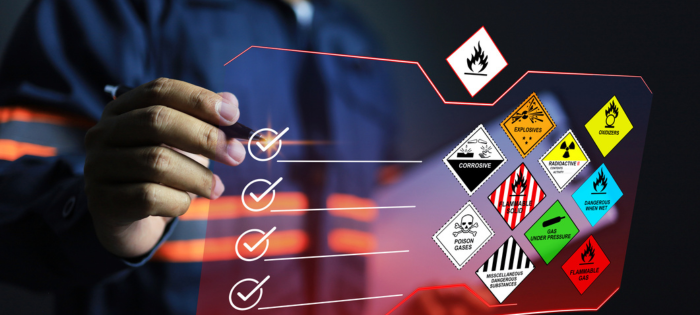
Safety
Comments: No Comments
In February 2021, the Occupational Safety and Health Administration (OSHA) proposed to modify the Hazard Communication Standard (HCS) to maintain conformity with the United Nations (UN) Globally Harmonized System of Classification and Labeling Chemicals (GHS) Revision 7, align certain provisions with Canadian and other U.S. agencies, and address issues with the 2012 HCS. Five years later, the final rule to update the HCS was published on May 24, 2024, and will take effect July 19, 2024.
HCS and GHS
The HCS was adopted by OSHA in 1983 to create a standardized approach for communicating about workplace hazards associated with hazardous chemical exposures. The standard requires chemical manufacturers and importers to classify the hazards of chemicals produced and/or imported to the U.S. and to communicate to employees about these chemicals through a Hazard Communication Program, which includes labels and other forms of warning, safety data sheets (SDS), and training. All employers with hazardous chemicals in the workplace must also have a Hazard Communication Program in place to inform employees about these hazards and protective measures.
Like the HCS, the GHS is an international standard that was created as a “universally harmonized approach” to classify chemicals and communicate hazard information. Warning pictograms that can be understood in any language are a key component of the GHS, in addition to universal standards for hazard testing criteria and SDSs. The UN updates the GHS every two years, with the most recent updates in 2023 with Revision 10.
Major Changes
OSHA’s recent HCS updates are the Administration’s first since 2012. The modifications are intended to:
- Improve hazard communication (e.g., precautionary statements) so employees are more aware of the hazards associated with potential chemical exposure and understand how to safely handle, store, and dispose of hazardous chemicals.
- Create a clearer hazard classification process to provide more complete hazard information on SDSs and labels.
- Incorporate new hazard classes and categories.
- Improve clarity and flexibility in requirements (e.g., small packages, packages released for shipment).
The table below highlights some of the updated HCS’s key changes.
| Area | Provision |
| Small package labeling | Provides special labeling alternatives for small containers when it is not feasible to use traditional labels containing full information: * Containers < 100 ml capacity: Use just the product identifier, pictogram, signal word, chemical manufacturer’s name/phone number, and statement that full information is provided on the immediate outer package. * < 3 ml capacity: Only the product identifier needs to be displayed. |
| Trade secret concentration ranges | Allows use of prescribed concentration ranges when exact percentages or ranges are claimed as a trade secret. |
| Health hazards | Updates the skin corrosion/irritation and serious eye damage/eye irritation chapters; adds non-animal testing methods. |
| Physical hazards | Expands physical hazards to include new hazard categories for flammable gases, desensitized explosives, and aerosols. |
| Label elements | Aligns with Revision 7 and includes new or updated hazards, updated guidance, and precautionary statements. |
| SDS | Revises Sections 2 (hazard identification), 3 (composition/information on ingredients), 9 (physical and chemical properties), and 11 (toxicological information). |
| Hazard classification | Clarifies which hazards must be evaluated and the hazard information required on the label vs. the SDS. |
| Packages released for shipment | Allows packages that have been released for shipment to not be relabeled. |
| Bulk shipment | Increases coordination with Department of Transportation (DOT), including allowing labels to be included on immediate containers or with shipping papers, bills of landing (BOLs), or other electronic means that are immediately available to workers on the receiving end of the shipment. |
| New definitions | Provides definitions for the following key terms: bulk shipment, combustible dust, gas, immediate outer package, liquid, physician or other licensed health care professional (PLHCP), released for shipment, solid. |
Compliance Dates
OSHA is taking a phased approach to implementation and compliance with the HCS based on whether the organization handles chemical substances or mixtures. During the transition period between July 19, 2024 (effective date) and the dates below, facilities may either comply with the updated HCS, the 2012 version, or both.
| Date | Requirement | Party | |
| Chemical Substances | July 19, 2026 | Update labels and SDSs | Chemical manufacturers, importers, distributors |
| January 20, 2027 | Update workplace labels, hazard communication program, and training | Employers | |
| Mixtures | July 19, 2027 | Update labels and SDSs | Chemical manufacturers, importers, distributors |
| January 20, 2028 | Update workplace labels, hazard communication program, and training | Employers |
Next Steps
While many of OSHA’s changes will provide additional flexibility to chemical manufacturers and importers, as well as alignment with GHS and international trading partners, the regulatory burden is not insignificant to those impacted. The fundamental structure of the HCS is not changing; however, the revisions will require companies to update SDSs, labels, and training. All of this will take appropriate and resources to meet deadlines. KTL can assist with creating plans and schedules for making these updates to help ensure your facility is ready by the applicable compliance date(s).
